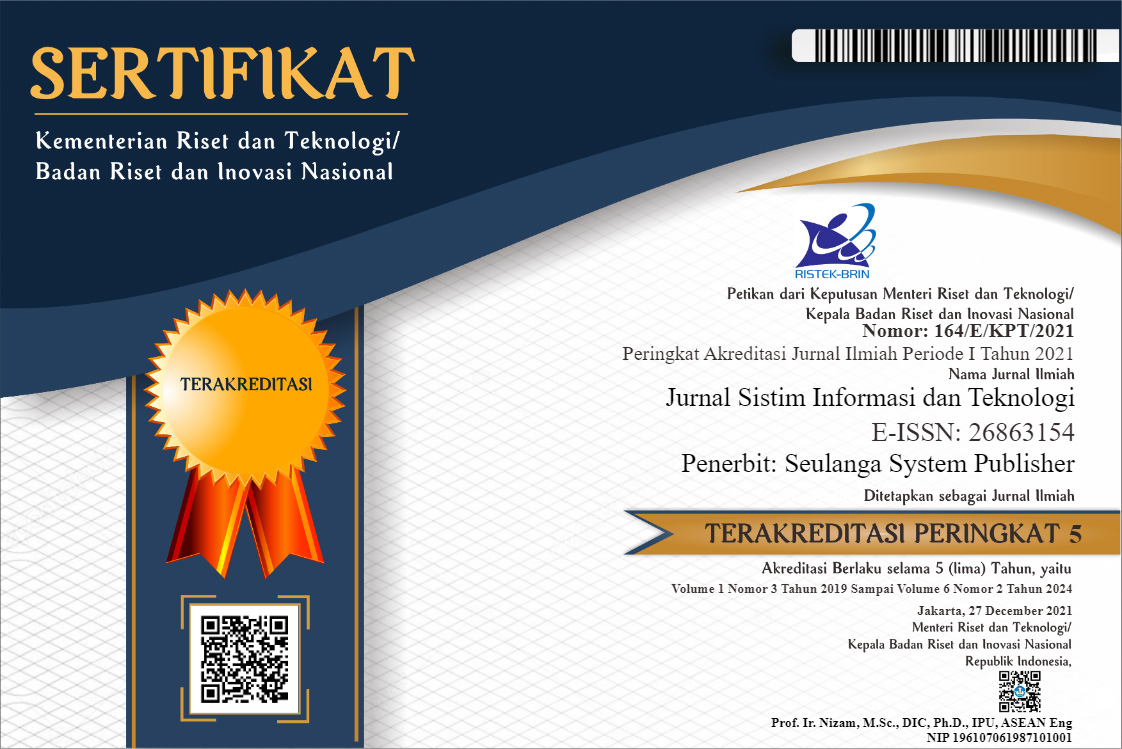Perancangan Dual-Axis Solar Tracker untuk PLTS dengan Analisis Pengaruh Jumlah Sensor dan Tracking Delay
DOI:
https://doi.org/10.37034/jsisfotek.v4i4.181Keywords:
Pembangkit Listrik Tenaga Surya (PLTS), Solar Tracker, LDR Sensor, Tracking Delay, Tilt AngleAbstract
One of the problems with Solar Power Plants (PLTS) is the angle of inclination during installation. Errors in determining the angle make PLTS not produce power optimally. In order for the power generated by PLTS to be optimal, the angle of inclination of the solar panels must be adjusted so that they face directly towards the sun. This study designed a dual-axis solar tracker using a microcontroller, a Light Dependent Resistor (LDR) sensor, and a servo motor. The effect of the number of sensors and tracking delay is analyzed to determine the output power of solar panels with different configurations. Testing from 07:00 to 17:00 for 2 days of testing, 2 days of tracking delay testing, and 3 days of testing of 3 PLTS installed. First on the dual-axis solar tracker and the rest with tilt angles of 0o and 30o. The results of the design of a dual-axis solar tracker on the x-axis rotates from 0o to 20o, while the y-axis rotates from 35o to -17o. Tests using 4 LDR sensors affect changes in the angle of the solar panels. Tests show tracking delay every 30 minutes and 1 hour has no significant effect. The power generated at the tracking delay every 30 minutes is greater, but the power consumed is also greater. During the test it was found that with a tracking delay of 1 hour it produced 1.76% greater net power. Final testing of dual-axis solar tracker and PLTS with tilt angles of 0o and 30o. During testing, it was found that the dual-axis solar tracker produces 16.89% greater power than at a tilt angle of 30o and 11.42% greater than an angle of 0o
References
Humas EBTKE. (2021). Indonesia Kaya Energi Surya, Pemanfaatan Listrik Tenaga Surya oleh Masyarakat Tidak Boleh Ditunda. Direktorat Jenderal Energi Baru Terbarukan Dan Konservasi Energi (EBTKE) Kementerian Energi Dan Sumber Daya Mineral (ESDM) Republik Indonesia. https://ebtke.esdm.go.id/post/2021/09/02/2952/indonesia.kaya.energi.surya.pemanfaatan.listrik.tenaga.surya.oleh.masyarakat.tidak.boleh.ditunda
Pribadi, A., (2021), Semester I 2021, Kapasitas Pembangkit EBT Tambah 217MW, Direktorat Jendral Ernergi Baru Terbarukan dan Konservasi Energi, dilihat 12 Oktober 2021, https://ebtke.esdm.go.id/post/2021/08/20/2940/semester.i.2021.kapasitas.pembangkit.ebt.tambah.217.mw
Kementerian ESDM Republik Indonesia. (2018). Peraturan Menteri ESDM Nomor 49 Tahun 2018 tentang Penggunaan PLTS. In Peraturan Menteri ESDM Tahun 2018 (No. 49). https://jdih.esdm.go.id/peraturan/Permen%20ESDM%20Nomor%2049%20Tahun%202018.pdf
Ramadhani, B. (2018). Instalasi Pembangkit Listrik Tenaga Surya: Dos & Don’ts. Deutsche Gesellschaft für Internationale Zusammenarbeit (GIZ) GmbH Energising Development (EnDev) Indonesia. https://ebtke.esdm.go.id/post/2018/08/31/2007/buku.panduan.instalasi.pembangkit.listrk.tenaga.surya
Kencana, B., Prasetyo, B., Berchmans, H., Agustina, I., Myrasandri, P., Bona, R., Panjaitan, R. R., & Winne. (2018). Panduan: Studi Kelayakan Pembangkit Listrik Tenaga Surya (PLTS) Terpusat. USAID Indonesia Clean Energy Development II. https://ebtke.esdm.go.id/post/2019/03/04/2152/panduan.studi.kelayakan.pembangkit.listrik.tenaga.surya.plts.terpusat
Seme, S., Srpčič, G., Kavšek, D., Božičnik, S., Letnik, T., Praunseis, Z., Štumberger, B., & Hadžiselimović, M. (2017). Dual-axis photovoltaic tracking system – Design and experimental investigation. Energy, 139, 1267–1274. https://doi.org/10.1016/j.energy.2017.05.153
Mi, Z., Chen, J., Chen, N., Bai, Y., Fu, R., & Liu, H. (2016). Open-loop solar tracking strategy for high concentrating photovoltaic systems using variable tracking frequency. Energy Conversion and Management, 117, 142–149. https://doi.org/10.1016/j.enconman.2016.03.009
Pulungan, A. B., Fajri, Q., & Yelfianhar, I. (2021). Peningkatan Daya Keluaran Panel Surya Menggunakan Single Axis Tracker Pada Daerah Khatulistiwa. JTEV (Jurnal Teknik Elektro Dan Vokasional), 7(2), 261. https://doi.org/10.24036/jtev.v7i2.113304
Jamroen, C., Fongkerd, C., Krongpha, W., Komkum, P., Pirayawaraporn, A., & Chindakham, N. (2021). A novel UV sensor-based dual-axis solar tracking system: Implementation and performance analysis. Applied Energy, 299, 117295. https://doi.org/10.1016/j.apenergy.2021.117295
Jamroen, C., Komkum, P., Kohsri, S., Himananto, W., Panupintu, S., & Unkat, S. (2020). A low-cost dual-axis solar tracking system based on digital logic design: Design and implementation. Sustainable Energy Technologies and Assessments, 37, 100618. https://doi.org/10.1016/j.seta.2019.100618
Wibowo, H., Bow, Y., & Sitompul, C. R. (2021). Performance Comparison Analysis of Fixed and Solar-Tracker Installed Panel at PV System. IOP Conference Series: Earth and Environmental Science, 709(1), 012003. https://doi.org/10.1088/1755-1315/709/1/012003
Pitowarno, Endra.(2006). Robotika : Desain, Kontrol, dan Kecerdasan Buatan. Yogyakarta : Penerbit ANDI.
Sendari, Siti, I Made Wirawan, dan Mokhammad Nasrulloh.(2021). Sensor Tranduser. Malang: Ahlimedia Press. dilihat 4 Desember 2021. https://www.google.co.id/books/edition/SENSOR_TRANDUSER/2SFREAAAQBAJ?hl=id&gbpv=1
Allegro MicroSystems,Inc, (2006),Fully Integrated, Hall Effect-Based Linier Current Sensor, dilihat 8 Juni 2022, dapat diakses di https://pdf1.alldatasheet.com/datasheet-pdf/view/168326/ALLEGRO/ACS712.html
Kadir, A. (2019). Dasar Pemrograman Robot Menggunakan Arduino (1st ed.). ANDI.
Suryawinata, H., Purwanti, D., & Sunadiryo, S. (2017). Sistem Monitoring Pada Panel Surya Menggunakan Data Logger Berbasis Atmega 328 Dan Real Time Clock DS1307. Jurnal Teknik Elektro, 9(1), 30–36. https://doi.org/10.15294/jte.v9i1.10709
Downloads
Published
How to Cite
Issue
Section
License
Copyright (c) 2022 Jurnal Sistim Informasi dan Teknologi

This work is licensed under a Creative Commons Attribution 4.0 International License.









